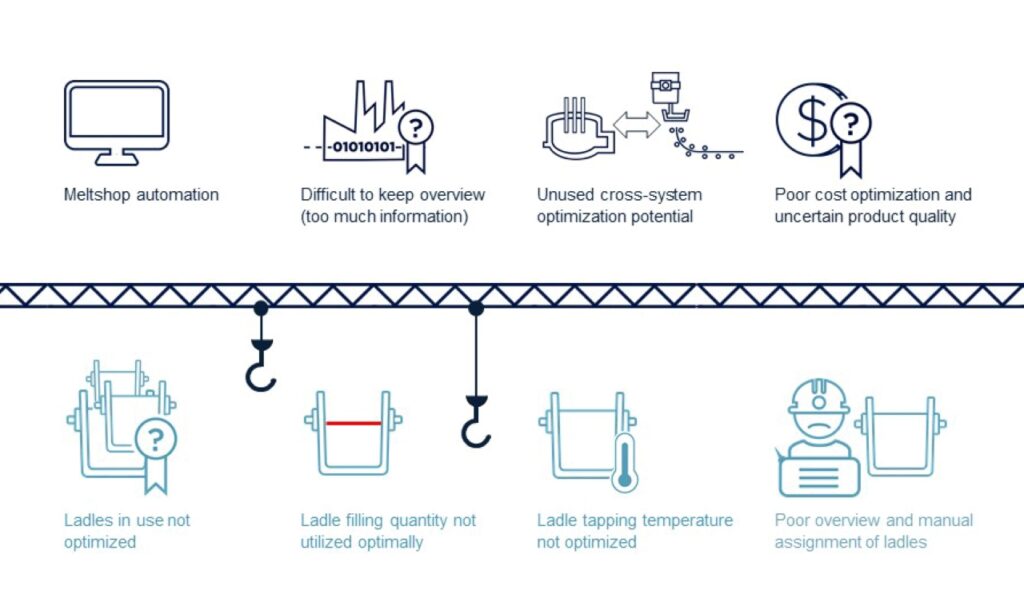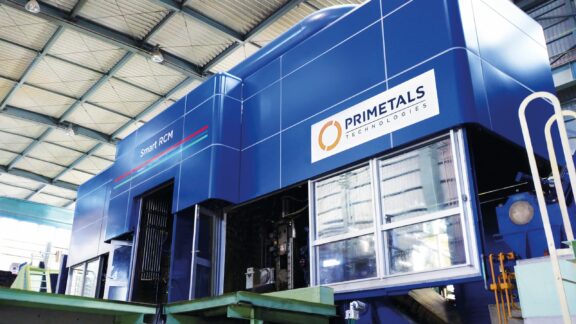Ladle tracking solutions cover all factors impacting an efficient and effective melt shop. From aggregate to integrated automation systems, ladle tracking solutions identify and overcome challenges facing steel producers.
Often understood as a system tracing the position of ladles in the meltshop, ladle tracking encompasses a variety of “trackable” information that aids in optimizing steel production. Providing answers to the many complex challenges facing operators, the ability for ladle tracking to improve operations has been proven time and time again to provide reliable and crucial information to steel producers.
The Complexities of the Meltshop
In any meltshop, operators face several challenges in their day-to-day routine that prevent the most efficient steel production possible. Some steel plants utilize labeled or painted ladles to keep track of ladles in the meltshop. However, these ladles cannot withstand the harsh environment of the meltshop. Labels and characters become difficult to read or easy to overlook, being subject to steel and slag splashes, and even in optimization strategies, manual entry of data can suffer due to the inability to identify a ladle correctly.
Beyond identifying a ladle based on labels or coats of paint, the mere physics of the varying temperatures in the meltshop can lead to an increase in operational expenses and unnecessary losses. While increasing capacities in the meltshop may involve more ladles, more ladles can mean longer wait times, which also means unwanted cooling. While idle ladles mean a loss in energy and investment, the temperature difference during tapping can cause unnecessary thermal stress on the ladle and lead to more wear and reduce the lifetime of the lining. Additionally, a ladle gets “washed out” during its lifetime, meaning it is possible to increase the tapping weight of a ladle, which may quickly amount to over one ton of liquid steel. However, if this change in yield is not recorded correctly, inconsistent or suboptimal performance can occur. Combine these factors with possible chemical residue from different steel grades, such as stainless steel, and the offline factors influencing the meltshop seem incalculable.
These different factors can significantly impact the production process, causing deviations from a regular meltshop rhythm, leading to heat loss and fewer heats per day. As steel producers also seek to modernize their meltshops to remain competitive and meet ever-changing requirements, new software solutions may collect data differently and in different forms while lacking in data reporting in some areas. Finally, as steel producers want to maintain production capacities and remain competitive, pressure to replace special lade equipment may result in unnecessary replacements, leading to net losses in the end. With all these challenges, the question remains, is there even a solution to all of these issues?
The “Perfect” Ladle Tracking Solution
The modern ladle tracking system goes beyond the visualization of the current ladle position by providing information about the current ladle enthalpy, steel grade history, and monitoring the refractory. These features combine to form a system designed to optimize the meltshop and improve steel plant operations. Using a combination of process control (Level 1), process optimization (Level 2), and smart sensors and systems integrated into the steelmaking process, the “perfect” solution covers the previously mentioned challenges facing operators in the meltshop and immediately enhances day-to-day production.


The key to optimizing ladle performance is automatically tracking equipment lifetime and optimal levels. The ladle tracking system gathers information about all ladles in use and analyzes this information across multiple units . Automatic tracking and identification of ladles ensure a transparent and seamless ladle history, essential to understanding the optimal filling level and higher yields. By automatically tracking thermal levels, the ladle tracking system increases the lifespan of the ladle and avoids unwanted cooldowns. By connecting these optimization features to the manufacturing execution system (MES), a “closed-loop” scenario emerges, leading to optimized ladle scheduling that automatically adjusts. Tracking the mechanical and thermal properties in the meltshop and production history is crucial for consistent and high-quality steel.
Integrated Answers
The key to any crucial solution is proven results. Over the past several years, ladle tracking systems made their way to ten meltshops in eight countries on three separate continents by Primetals Technologies. The ladle tracking systems were installed to handle various challenges, including slag pot tracking, slag chute tracking, ladle tracking, dummy bar tracking, and tundish tracking. In 2020, one of the largest steel producers in the US invested in a ladle tracking system to monitor position, contact times, thermal states, maintenance, and repairs of ladles in real-time.
The variability of the ladle tracking system means the system itself can cater to various needs within the meltshop and across the steel plant. Using “ICE tag RFIDs” developed by Primetals technologies, these chips in fire-proof enclosures on the ladles themselves help continuously record accurate data. This innovative solution can integrate with and modernize obsolete automation systems for LD converters, electric arc furnaces, ladle furnaces, and continuous casters by gathering information through a single source.
By supplying steel producers with a continuous flow of consistent data, the ladle tracking system can combine with Level 2 solutions and process models, making the meltshop even more efficient. In the end, steel producers can confidently realize the optimal layout and effective operation of their meltshops. If perfection does not exist, the ladle tracking system is proud to come as close as possible by providing optimal solutions to various challenges.
MORE INFORMATION
Learn more about the latest in Ladle Tracking Solutions in our expert video series and connect with us on LinkedIn

